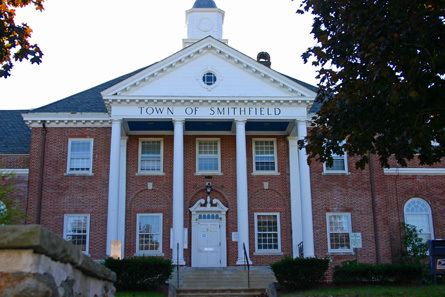Country United States ZIP codes 02828, 02917 Elevation 122 m Local time Friday 2:26 PM | State Rhode Island Time zone Eastern (EST) (UTC-5) Area code(s) 401 Population 21,430 (2010) | |
 | ||
Weather 4°C, Wind SW at 19 km/h, 60% Humidity | ||
Holiday inn express and suites smithfield providence smithfield rhode island
The town of Smithfield is located in Providence County, Rhode Island, United States. It includes the historic villages of Esmond, Georgiaville, Mountaindale, Hanton City, Stillwater and Greenville. The population was 21,430 at the 2010 census. Smithfield is the home of Bryant University, a private four year college.
Contents
- Holiday inn express and suites smithfield providence smithfield rhode island
- Map of Smithfield RI USA
- History
- Demographics
- Education
- Bryant University
- Notable people
- References
Map of Smithfield, RI, USA
History
The area comprising modern-day Smithfield was first settled in 1636 by several British colonists, including John Steere as a farming community and named after Smithfield, London. The area was within the boundaries of Providence until 1731 when Smithfield was incorporated as a separate town. Chief Justice Peleg Arnold lived in early Smithfield, and his 1690 home stands today. There was an active Quaker community in early 18th century Smithfield that extended along the Great Road, from what is today Woonsocket, north into south Uxbridge, Massachusetts. This Quaker community, and its members, became influential in the abolition movement, with members such as Effingham Capron and Abby Kelley Foster, and also gave rise to other Quaker settlements including one at Adams, Massachusetts where Susan B. Anthony was born as an early member. Elizabeth Buffum Chace is a well-known person from Smithfield who was influential in both abolition of slavery, and the women's rights movement. In the 19th century several mills were built in the town. In the mid-19th century the towns of North Smithfield, Rhode Island, and Lincoln, Rhode Island, became separate towns. The colonial ghost town of Hanton City is located within the boundaries of present-day Smithfield, but was a completely separate community in the eighteenth century. A Revolutionary war soldier, from the Smithfield side of the Massachusetts border, Captain James Buxton, ended up as a Massachusetts militiaman and Continental Army veteran, who was deeded 300 acres in Worcester County by Governor John Hancock. For this reason Buxton was lost to the history of Rhode Island Revolutionary soldiers.(see South Uxbridge history). Buxton served at Valley Forge among other battles.
Demographics
As of the 2010 United States Census, Smithfield has 21,430 residents with a median age of 42 years and 16.9% of the population under the age of 18. The racial makeup as of 2010 was 95.7% White, 1.2% African Americans, 0.15% Native American, 1.31% Asian, 0.03% Pacific Islander, 0.58% from other races and 1.03% of two or more races. Hispanic and Latino of any race made up 2.17% of the population. The median household income is $71,305 and 4.1% of the population live below the poverty line.
Education
Smithfield contains four public elementary schools, a middle school and a public high school, which was ranked 17th out of 52 high schools in Rhode Island in 2006. St. Phillip's School, a private Roman Catholic academy offering education in grades K-8, is situated in Greenville. Mater Ecclesiae College, a Catholic college, is also located in the town in a facility that was formerly the St. Aloysius Orphanage.
Bryant University
Bryant University, a private university with programs in business and the arts and sciences, is located in Smithfield.
In 1971, the University moved to its current campus in Smithfield when the founder of Tupperware, Earl Silas Tupper, a Bryant alumnus, donated the current 428 acres (1.73 km2) of land to be the new campus. The famous Bryant Archway was also relocated. The old Emin Homestead and Captain Joseph Mowry homestead occupied much of the land that makes up the present day Smithfield campus. The land was purchased and farmed for three generations between the late 19th century and the mid-20th century. Today, many descendants of the original Emin settlers still live near the Bryant campus. The school also claims a handful of family members as alumni and offers a scholarship for accounting students as a tribute to the Emin family. Historical pictures of the Emin Homestead can still be found in the Alumni house.
